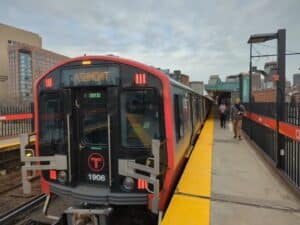
One of the MBTA's new Red Line trains pulls into Charles MGH station in early 2023. Photo by James Sanna | Banker & Tradesman Staff
A new analysis of trip time data on the MBTA’s Red Line suggests a major shutdown of one of its branches delivered the big improvements promised by the transit system’s leaders.
The T shut down the Red Line’s Ashmont Branch and associated Mattapan Trolley line for half a month, from Oct. 14 to Oct. 29, to fix what were some of the worst track conditions in the T’s subway network, caused by years of deferred maintenance, that forced the agency to run trains at achingly slow speeds along the nearly 3-mile stretch that forms most of Dorchester’s mass transit backbone.
The shutdown was necessary, MBTA General Manager Phil Eng said when he first proposed the closure in late August, to give work crews around-the-clock access to address the huge backlog of repairs. The result, he promised, would be an Ashmont Branch that ran as fast as it had before maintenance issues piled up in recent years and one that looked better, since T staff would have two weeks to deep-clean and repaint stations, among other important station maintenance tasks.
That promise appears to have been kept. Watchdog group TransitMatters examined publicly available data on how long it took subway trains on the Red Line’s Ashmont Branch to travel from its terminus deep in Dorchester to the JFK/UMass station, where it joins with the rest of the subway line, and found the 16-day shutdown sliced travel times on the branch nearly in half.
From an average southbound speed of 17 minutes and 6 seconds in September, by the end of last week trains were making that journey in 9 minutes and 16 seconds, TransitMatters found. Northbound trips saw a similar change, from a 15-minute, 7-second trip in September to an 8-minute, 12-second journey seven days after the line reopened on Oct. 30.
That means both southbound and northbound trips are now faster than they were in October 2018, when trains made the southbound run in 9 minutes and 38 seconds and the northbound run in 8 minutes and 33 seconds. TransitMatters said the shutdown’s results mean riders collectively save over a year’s worth of time every day.
TransitMatters said its data analysis shows that one single slow zone remains on the Ashmont Branch, down from eight before the shutdown.
The Ashmont shutdown was the T’s first major maintenance shutdown on its subway network since late summer 2022, when under previous leadership it abruptly closed the entire Orange Line for a month but lost significant public trust by failing to deliver faster speeds, TransitMatters and other advocates said following the closure.
Then-General Manager Steve Poftak and Baker administration officials had claimed the disruptive “surge” of maintenance work would let the T fix some of the excruciating slow zones on that line that added 20 minutes to a trip on the line, but trip-time data analyzed by TransitMatters after the shutdown showed the line actually ran marginally slower after the fact.
In its analysis of the Red Line shutdown, TransitMatters wrote that the results showed the T can make these kind of multi-week maintenance shutdowns work – provided they’re done correctly.
“Already, the Ashmont Branch and Mattapan Line shutdown has yielded more positive feedback, proving these shutdowns can work if you give riders adequate time to prepare, viable alternative forms of transportation, and, most importantly, tangible results to show for the inconvenience,” the watchdog group wrote.
In an emailed statement TransitMatters volunteer Nathan Weinberg, who helped run the analysis, explained that the group is “cautiously optimistic” that future shutdowns will be like the recent Ashmont Branch shutdown thanks to new leadership at the T and in the governor’s office.
TransitMatters wrote the T should continue with more maintenance closures to address slow zones across the system, but only if it creates a strategy for them and releases a calendar of future shutdowns.
The T’s own data shows that 20 percent of the Red Line, 33 percent of the Blue Line, 17 percent of the Orange Line and 23 percent of the Green Line are still afflicted with slow zones.
“We don’t want to speculate too much, but given the amount of slow zones present in the system and comments made publicly by Eng, riders can likely expect several other shutdowns similar to this across much of the system where slow zones are most pervasive. We hope as the system moves towards a state of good repair the need for shutdowns will dissipate and track maintenance can be handled in shorter windows that are less disruptive to riders,” Weinberg said.






